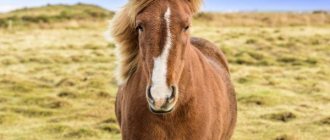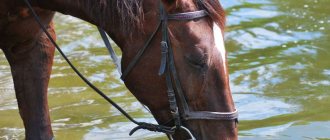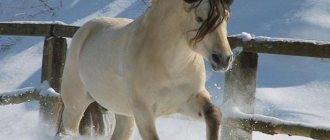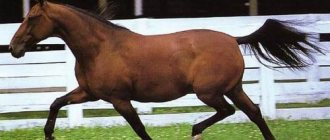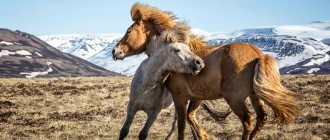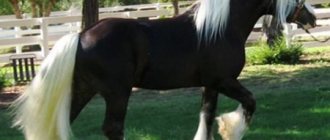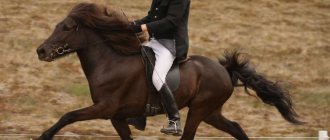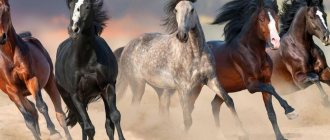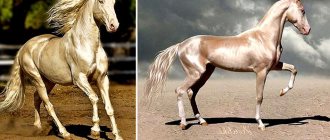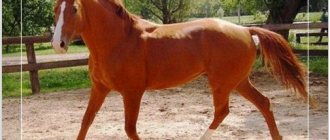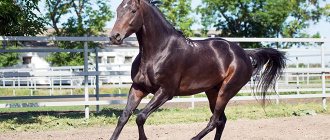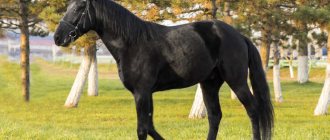ExpertBusiness
The popularization of equestrian sports in the country will be able to give impetus to the revival of Russian horse breeding and the return of the position of domestic horses in the world market
Liliya Boyko
Few of us realize how huge this industry is - horse breeding. According to the roughest estimates, approximately $300 billion is circulating in the world. Our country’s place in the global horse breeding industry is still very modest.
In February, representatives of the horse breeding industry met at the forum “Russian Horse Breeding and Export: Myth or Reality,” which was jointly organized by the Rosplemkonzavod Association, the All-Russian Research Institute of Horse Breeding and the Timiryazev Academy. One of the prerequisites for the meeting was the decision of the Russian government to increase the volume of exports of agricultural products to $45 billion per year in 2024. And horse breeders decided not to stand aside. Forum participants discussed the state of the industry, many important details related to the transportation and registration of animals, and other relevant topics. However, among the speakers there was not a single horse breeder who had experience in exporting horses; there was not a single shining success story; markets and consumer profiles, specific numbers were not discussed.
The industry, as many participants put it, is “lying” or on the verge of survival.
Nevertheless, the export of horses from Russia is not at all a myth: in 2017, according to the UN Statistics Office, our country exported 140 thoroughbred horses and 552 non-pedigree horses. The annual income from the export of thoroughbred horses, according to the same source, amounted to 295 thousand dollars. This is roughly comparable to the cost of one purebred foal with a stellar pedigree from Great Britain, which, by the way, is among the top leading exporters year after year. In the same year, the UK earned $406.5 million from the export of thoroughbred horses.
Historically, Russia is an equestrian power, and horses are an integral part of cultural tradition. At the beginning of the twentieth century, our country had the largest population of these animals, so the current meager numbers are especially offensive. Before perestroika, the USSR was a significant player at the international level. The auctions, which were held at many stud farms, attracted buyers from all over the world. Alas, those auctions are no longer there, many positions have been lost, traditional buyers and markets have been lost, and it will be very difficult to restore them. The list of problems includes the quality of horses, the level of their training, and the ability to sell - modern marketing, integration into the world system, reputation. The losses of the nineties include the broken ties between athletes, a wide layer of the physically active population and horse breeders, and the fact that the development of horse breeding in Russia took on a spontaneous character.
How the world's horse population has changed
The horse was domesticated after dogs, pigs, cattle, sheep and goats. This happened in 5500 years. But the horse has had the greatest influence on human history. It became the fastest means of transport that changed the speed and scale of the movement of people and goods, diseases and cultures. Horses revolutionized warfare and agriculture. But human activity also influenced the evolution of horses.
Wild horse population
Wild populations of these animals have declined sharply around the world. In 1909, the Tarpan horses, which had inhabited Eastern Europe for many centuries, disappeared. Now their only wild surviving relative is the Przewalski's horse, but it is also on the verge of extinction. The specimen was first described in 1870.
He was seen in the steppes of Asia. After 90 years, the Przewalski's horse was officially declared extinct in the wild. Now this animal is preserved only in captivity thanks to special programs. 12 – 16 individuals managed to reproduce up to 2000 copies. They are mainly found in reserves in Mongolia and China. The Przewalski's horse is now considered an "endangered species," an upgrade from "extinct in the wild."
Hobby with hope for the best
According to experts, there are about one hundred thousand horses for sports or amateur pursuits - riding and light draft - in Russia. It is almost impossible to obtain more accurate data on sport horse breeding, since there is no compulsory licensing of breeding activities and no strict accounting.
Breeding - reproduction of livestock - is the basis for the development of the industry. It is impossible to even accurately determine what we now call breeding farming. According to the criteria of the All-Russian Research Institute of Horse Breeding, there are approximately 6,200 of them in the country, and according to the State Register - 2,200. It is impossible to say exactly how many breeds of horses we have. The State Register records 50 breeds and breed types, but it is known that three of them have practically disappeared.
According to the general director of Moscow Stud Farm No. 1, Yuri Prokhorov , there are no profitable stud farms in Russia today. This statement is shared by other market participants with whom Expert was able to talk. Factories are mostly teetering on the edge of survival or are kept alive thanks to sponsors for whom horse breeding is an expensive and prestigious hobby. Here are some calculations as an example. The expenses of a horse breeding farm, which is located outside the Moscow region, for approximately 70 heads, including stallions, dams and foals, amount to seven to eight million rubles per year. These are costs for personnel, food, veterinary care, routine repairs, etc. About half of the livestock are foals. Their number fluctuates from year to year. The income comes mainly from the sale of foals. One foal costs approximately 100–150 thousand rubles. Foals live on the farm for up to three years. Let’s say that last year 12 foals were sold for an average price of 135 thousand rubles. The result will be 1.62 million rubles, which is several times less than the expenditure portion. Therefore, as a rule, the horse breeding business is not the main business for horse breeders; they all have another source of income, and they most often engage in breeding because they know this business well, and sometimes because they cannot quit, but in any case they believe in the future of this industry.
When breeding pedigree horses, an important stage is checking the young stock for the presence of the necessary qualities, which must be confirmed and improved from generation to generation. Agility, jumping ability, endurance - each breed has its own criteria. And everyone wants beauty - there are certain requirements for the exterior. Young horses of both sexes are tested at hippodromes - by the way, this is one of the functions of the Central Moscow Hippodrome.
According to the director of the All-Russian Research Institute of Horse Breeding Alexander Zaitsev , of all the breeds existing in Russia, only six breeds have a regulatory framework for testing. This situation is unsatisfactory: lack of testing will inevitably turn the horse into an ornamental companion animal weighing half a ton. It is very important to expand the range of breeds tested.
The number of tests has also been significantly reduced. If, according to Galina Kalinina, chief registrar of the Oryol trotting breed and head of the selection department of the All-Russian Research Institute of Horse Breeding, in the nineties approximately 60–65% of horses were tested, today only about 20%. The reasons are complex logistics and its high cost: a small farm is often unable to transport animals and keep them outside their home walls. Thus, in 2022, Moscow Stud Farm No. 1 had to pay 3.5 million rubles for the stay of 10–12 horses that were being tested at the Central Moscow Hippodrome for a year.
Some private breeders prefer to test their horses at foreign racetracks, where there is a prepared infrastructure and the opportunity to obtain the “correct” documents, which immediately allow the horse to be integrated into the international system. A studbook, or breeding book of a particular breed, is a document in which information about breeding animals is entered, their quality and origin are recorded in it. Studbooks are the basis for breeding work: stallions are licensed for use in breeding only if they meet the accepted breed standard. The use of such a manufacturer for breeding is possible only by agreement with the holder of the studbook, since horse breeds are objects of copyright.
Domestic horses
While wild horses were disappearing from nature, man was changing the history of domestic horses. But recently, in addition to the particularly popular thoroughbred racehorses, a significant part of these animals are under threat of extinction. By 2015, 87 horse breeds had already become extinct, and 905 were on the verge of extinction.
According to the Food and Agriculture Organization of the United Nations, there are 58,372,106 horses preserved in the world. The largest number of them is in the United States - 9.5 million. In China, the number of horses is about 7.5 million, in Mexico - 6.2 million, Brazil - 5.7 million, Argentina - 3.7 million, Colombia - 2 .5 million, Mongolia – 2.01 million, Ethiopia – 1.7 million, Russia – 1.3 million, Kazakhstan 1.2 million, Guam – 20 individuals, Rwanda – 30 individuals.
A strong increase in the horse and mule population was observed between 1867 and 1869. Then the number of horses in the world increased by 70%, and mules by 37%. In those years, the number of horses reached 23 million. In the USA, a special peak in the number of horses was reached in the middle of the First World War. This was facilitated by intensive breeding programs. In 1914, there were about 25 million individuals in the United States. More than half of all horses available in the world at that time were in the Russian Empire and the United States. Americans sent more than a million horses and mules to Europe during the First World War.
A sharp decline in the number of horses began in 1920 - 1940. This was caused by the advent of tractors. Many animals were sent for slaughter. After World War II, the power of agricultural machinery began to increase. It exceeded horsepower many times over. And the main factor for this was the Second World War. This became especially noticeable in the USA.
A large number of farmers became rich by supplying food to the front. They became financially wealthy and could now afford to buy tractors and other mechanical equipment. In the 70s of the last century, the number of horses in the world reached its lowest level. But at one time horses had a great influence on the development of the economies of many countries.
Russia is the country with the largest horse population in the world. In the European part of the Russian Federation alone there are more than 22 million individuals. On average, there are 26 horses per 100 people. There is no such indicator in any other country in the world. Since there are no statistics, the number of these animals in the eastern part of Russia is difficult to calculate, even approximately. However, thanks to some information, it can be assumed that in the eastern part the number of horses is no less than in the European part, and perhaps even more.
In 1866, the number of horses among the Kyrgyz living in the steppe zone of Siberia reached 300 thousand. The poorest families usually kept 15-20 horses, and in the rich their number could reach 5 thousand, 8 thousand or even 10 thousand heads. Therefore, we can make the assumption that the number of the Kyrgyz horse alone reaches several million. There are also other breeds of horses in Siberia, as well as countless wild individuals. It’s also worth considering the horses in the Caucasus. Thus, most of the world’s horse population lives throughout the Russian Federation.
Svenska Dagbladet 06/03/2018 Lidovky 03/14/2017 The Washington Post 05/08/2012
Russia may be the place of origin of some horse breeds, since, according to scientists, all domesticated horses originated from wild horses that lived in the steppes of Central Asia, which are now mainly located on the territory of this state. Thus, horses, together with various tribes, first came to the European part of Russia, and then appeared in Western Europe. This process continues to this day, so Russia occupies a special place in the study of these animals.
© flickr.com, Maarten Takens Yakut horse in Oymyakon
The variety of horse breeds in Russia is as rich as the climate, soil and life of the people of this country. However, if we talk about climate and soil, then all this has its own characteristics. And horses have a common characteristic that unites them. In fact, all horses in Russia, whether they are steppe horses or have not lived there for a long time, belong to the species of light or eastern horses. An exception can only be found on horse breeding farms.
Steppe horses usually mean horses born in the steppes and living in loose herds or schools (family group of 5-20 heads). They eat grass under their hooves almost all year round. In a word, all non-domestic horses are called steppe horses. This group includes wild horses or horses lost by their owners. There are also semi-wild horses of nomadic peoples: Kyrgyz, Kalmyk, etc. And also Don and Caucasian.
Most horses in the European part of Russia, including agricultural ones, do not belong to the steppe species. Their appearance is relatively recent. Horses from horse breeding farms are special animals. Almost all of them were brought from abroad or were crossed between local and foreign individuals. Among them there are those who have almost completely inherited the characteristics of their foreign parents. Others, despite their origin, under the influence of climate, soil and diet, acquired even more unique features. The Russian trotter serves as such an example.
InoSMI materials contain assessments exclusively of foreign media and do not reflect the position of the InoSMI editorial staff.
Interesting bits of history related to horse numbers
Pharaoh Thutmose III in 1469 BC captured 2041 horses from the enemy at the Battle of Megiddo. To do this, he had to walk 10–15 miles a day. Even then, horses were valued as a means of war. The tactics of fighting on horseback were developed by the steppe nomads.
During the American Civil War, horses were not only used for transportation, but also for transporting supplies and artillery pieces. About 3,000 horses were killed during the battles at Gettysburg. But at the same time, the number of horses continued to grow. In 1870 there were 8.3 million of them in the United States, and by 1900 there were already 21.5 million.
In 1940, the domestic horse population was half what it was before the First World War. By the beginning of the war, many countries had reduced the number of cavalry, replacing them with vehicles. But horses in the army still continued to be used as pack animals.
During World War II, the armies of the warring countries still traveled on horseback. The German army had 2.7 million horses in service. There were 200 thousand of them in Poland. At the beginning of the war, the Americans used 50 thousand horses in the army.
But after the end of the war, thousands of horses were slaughtered, exhausted by disease and the problems of returning them to their homeland.
Current use of horses
Currently, horses are bred for various purposes: as draft power, for meat, for milk, for participation in sports competitions, for tourism and recreation.
For a long time, horses were the main means of land transport; they were ridden on horseback and harnessed to various carts and sleighs. It was horse traction that was used in stagecoaches and horse-drawn horses that were used as the first types of intercity and urban public transport. The era of horses as the main means of transport over short distances ended in the first half of the twentieth century.
However, in some remote and inaccessible areas, for example, in the highlands, horse transport still continues to be of considerable importance. Despite the widespread use of machinery in agriculture, working horses are still used for transporting small loads, plowing vegetable gardens and virgin lands, harvesting and hauling hay in hard-to-reach places, and herding goats and sheep. The value of work horses is especially great in areas where machinery is scarce or impossible to use. For example, in countries of Africa, South Asia, Central and South America. Horses are also valuable as suppliers of meat and milk. Horse meat is the traditional meat consumed by nomadic peoples. The production of horse meat is widespread in Mongolia, the countries of Central Asia, as well as in some regions of Russia, such as Yakutia and Tyva. In agricultural areas, horse meat is rarely used as food.
In Western Europe, horse meat is used to prepare certain types of smoked sausages for dog food. Eating horse meat is considered reprehensible in Great Britain, Ireland, and the USA. Horse meat is not eaten by gypsies, but by residents of Brazil and India, Jews, and residents of some countries in the Arab world.
The leading producers of horse meat in the world in 2011 were China (161 thousand tons), Mexico (83), Kazakhstan (76), Russia (48 thousand tons). The main exporters of horse meat: Argentina, Canada, Mexico, Poland, Mongolia , Uruguay. Leading importers of horse meat: Italy, Russia, Belgium, France, the Netherlands, China, Switzerland, Japan, Kazakhstan. Koumiss, prepared from mare's milk, is considered a healing drink. It has a tonic and healing effect, treats diseases of the gastrointestinal tract. Recently, mare's milk has been used to create human milk substitutes. The selection of horses in Yakutia, Bashkortostan, and Mongolia is aimed at creating breeds with good quality milk. Products obtained from horses are used to create various serums and pharmacological preparations.
The military use of the horse began in Mesopotamia in the third millennium BC.
Horse units gradually became a special branch of the military - cavalry, and before the advent of motorized equipment, horses were a mobile part of the armed forces. The army used horses to transport food and ammunition, transport artillery, and transport the wounded and dead from the battlefield, for communication between headquarters and units. The most widespread use of horses was during the First World War, but also during the Second World War. Cavalry units solved serious problems. The USSR abandoned cavalry in 1955.
Currently, in some countries horses are used by mounted police. The small surviving cavalry units are used in the ceremonial reception of international delegations, for ceremonial parades, and in the filming of historical films. In many countries around the world there are mounted police units patrolling parks, forests, recreation areas, places of public celebrations and sporting events. Mounted police officers effectively deter or disperse unauthorized rallies and demonstrations.
Feral horse populations
In addition to wild and domestic horses, there are also feral horses in the world. The most famous of these feral horses are the American Mustangs. These horses were once forgotten or abandoned to their fate. Such feral herds can be found on all continents except Antarctica. But the fate of these horses in most cases is deplorable. They often disappear because of hunters who like to shoot. Recently, the largest group of feral horses is considered to be the population on Vodny Island in the Russian Rostov Nature Reserve.
Horse management
Owning horses requires significant expenses. Horses are demanding when it comes to feed. On pasture they eat from 25 to 100 kg of grass per day. To feed one horse you need about 2 hectares of land. Depending on age and live weight, a horse drinks an average of 30-60 liters of water per day in summer and 20-25 liters in winter. Horse breeding is an extensive branch of livestock farming.
Herd method
Horses can be kept in herds or stables. When keeping herds, animals are kept on pastures around the clock. On pastures, herds of horses feed on succulent grasses.
Stable method
In the stable method, horses are kept in stables sheltered from the weather. When keeping horses in stables, special paddocks are required for walking animals. The feed for horses kept in stables consists mainly of oats and hay or straw. The horses are also given root vegetables, potatoes and other food.
The method of keeping horses varies depending on the season of the year and climatic conditions. In summer, horses are grazed in herds on pastures, and in winter they are kept under a roof in stables.
"Equestrian" countries
There are hundreds of countries on the planet, and horses live in each of them. In the “Countries” section, we introduce readers to equestrian traditions from around the world.
Many countries are distinguished by their special breeds of horses. Thus, Portugal is the birthplace of the magnificent Lusitano, and Russia is the birthplace of the Oryol trotter.
In each country, the attitude towards horses has its own specific characteristics, and equestrian sport has its own heroes - we talk about all this in our section.
A number of articles are devoted to such, without exaggeration, an equestrian power as Great Britain. Horse racing, dressage, show jumping, equestrian polo, magnificent stud farms and hippodromes - Foggy Albion has it all. However, Japan and Brazil, Africa and Morocco have their own distinctive equestrian traditions. Articles about these countries will be no less interesting for equestrians than the equestrian traditions of Holland, France, Denmark, the USA and Germany.
In 2016, the world learned that, following a referendum, Great Britain would leave the European Union at the end of 2020. January 2021 became the starting point for a new life outside of European agreements. The exit will affect a huge number of economic and humanitarian aspects. Of course, it will have an impact on the equestrian industry, in which the country traditionally occupies a leading position.
The past year, as usual, was generous with equestrian events: world championships, top-level shows, horse races and, of course, specialized exhibitions. Such events have long ceased to be just trading platforms - today they attract hundreds of thousands of guests and have such a rich program that, year after year, surprises even the most severe skeptics.
I didn't plan to go to India. Having succumbed to stereotypes about dirty and noisy streets, annoying people, unpleasant smells and total poverty, I decided that I would leave this tourist destination for later. But the Universe seduced me with a spontaneous horseback riding trip, and now - from New Delhi airport, 5 hours by minibus to Jaipur, from there by taxi to Fort Dundlod - and I am in the middle of India, which surprised me.
Wherever have international equestrian competitions been held? Football stadiums, ice arenas, polo clubs, or even temporary grounds built “once”. But in this selection we will talk specifically about stationary equestrian centers, the largest in the world. Let's call them “equestrian stadiums.” Each of these places is unique in its own way and is a treasure not only of its country, but of the entire global equestrian community.
European legislation on cruelty to animals is very different from Russian legislation. However, should we rush to adopt Western experience? It turns out that “they” also have problems both in implementing regulations on the responsible treatment of animals and in controlling it.
This “directory” first appeared in 1955 at the request of the Irish brewery. It was originally designed to allow pubgoers to find answers to quiz questions in a wide range of areas of knowledge. Today, all information can be found on the Internet, but the excitement of getting into the most famous rating in the world - the Guinness Book of Records - remains.
At the end of February, a wave of reposts of heartbreaking photographs swept across the Internet. The photo showed a gray horse with a bloody mouth. Every self-respecting horseman and animal defender considered it his duty to repost the terrible picture and express his outrage. But what were the true reasons for such indignation?
Horse plus man
The specificity of the industry is that its development is based on a tandem: a horse plus a rider or equestrian (equestrian sport is the only Olympic sport in which an animal and a person participate; according to the regulations, they enter the awards together). This is what makes the industry unique, taking it beyond simple agricultural production. The most prominent developments in the industry are horse racing, sports and riding as part of a lifestyle, sometimes referred to as "leisure" for short.
The uniqueness of equestrian sport is that there are no restrictions on gender or age - women and men compete on equal terms even in Olympic disciplines. Compared to other sports, the age group “over 45” is more widely represented here, as well as people with disabilities. This is a virtually unlimited market.
Europe and America managed to maintain the industry even after the need for horses in military affairs, agriculture and as the main means of transport was no longer necessary. Traditions have changed, but continue to live. Foreign experience shows that neither scientific and technological progress nor changes in living conditions of the population are critical factors for the destruction of the horse industry. And this is exactly what happened in our country. Among the reasons are the underdeveloped domestic market, weak infrastructure, high cost of keeping horses, low level of trust, shortage or insufficient qualifications of personnel, mass import of foreign horses of average and “below average” quality.
The Oryol trotting horse breed has been preserved thanks to the efforts of Russian horse breeders
Status and prospects for the development of the main areas of horse breeding in Russia
It is almost impossible to imagine a person’s life a hundred years ago without a horse. Today, horses are almost never used as a means of transportation; they have been replaced by cars. But these changes do not concern the economic side of life and nutrition. Horses are bred for meat and milk, and this area of horse breeding is growing every year. And areas such as sports, entertainment and racetracks have an annual turnover of billions of dollars around the world.
Horse breeding in Russia today
Today, the global horse population is more than 65 million horses, of which two million are located on the territory of the Russian Federation. The lion's share, about 80% of all domestic horses, is used in agriculture. Significantly less horses are used for sports, entertainment and food production.
But such a small number for such a large territory does not fully reflect the need for horses in different spheres of life. Various studies show that with such a population, twice as many horses, up to 4 million heads, can be effectively used for various purposes on our territory.
Sports horse breeding
How did the horse appear?
Nothing in the world appears from nowhere and disappears into nowhere. Everything has its beginning and end. So is the horse. This is one of the most beautiful creations that arose as a result of nature’s long and painstaking work over many millions of years. Over the course of a long time, a great variety of animal species have appeared on our planet. These were various unicellular organisms, as well as multicellular ones. But one day nature created an animal that combined speed, endurance, strength and beautiful body lines. They became a horse well known to everyone.
Rice. 1. Arabian purebred breed
This chapter will briefly talk about the origins, the long journey that the horse went through before it became what it is now.
Scientists classify all horses as belonging to the order of odd-toed ungulates, to the equine family, to the genus of horses. It took nature tens of millions of years to develop the horse in its modern form. This was a long process, during which a large number of intermediate forms appeared. At the very beginning, the study of the origin of the horse was based mainly on rock paintings that ancient people left behind in time immemorial. Subsequently, researchers began to study animal bones.
Rice. 2. Akhal-Teke breed
Paleontological and archaeological excavations were organized, during which a huge number of bones were dug up. This allowed scientists to recreate the appearance of the horse's ancestor. Later, using the method of radiocarbon dating, it was possible to more or less accurately determine the age of these ancient bones. As it turned out, the evolution of the horse genus, according to conservative estimates by scientists, began approximately 71 million years ago, when the distant ancestors of humans still lived in trees.
The beginning was made in the Tertiary period.
As everyone knows from school, the great scientist Charles Darwin wrote the book “The Origin of Species” in 1859, in which he revealed the driving forces of evolution.
With the help of this teaching, it was possible to comprehend and understand the process of formation and development of animal organisms. Subsequently, Darwin's teachings were developed in the works of many scientists. In particular, the work of the Russian scientist V. O. Kovalevsky (1842–1883) is a worthy continuation of Darwin’s theory. At the same time, he is the founder of modern evolutionary paleontology.
In the second half of the 19th century. V. O. Kovalevsky formulated the main patterns of development of horse evolution. He suggested that there must be transitional fossil forms of modern monoungulates.
And this was later confirmed. He identified the trend and main stages of the evolution of the ancestors of ungulates and established that this process is constantly exposed to the changing conditions of their existence in the environment. This was expressed in a gradual transition from living in the forest zone to living in open spaces. Here the primary need was to run fast and eat tougher plant foods. This is visible in the structure of the limbs and jaw apparatus.
The first ancestors of the horse appeared at the same time in Eurasia and on the American continent. These were small animals no larger than a modern fox. They lived in the forest zone, as evidenced by the structure of their teeth, adapted to succulent plant food.
But it is believed that the paleontological history of the horse begins with the genus Hyracotherium. Chiracotherium lived in Western Europe, and Eohippus lived in North America. These were small animals, with a height at the withers from 25 to 56 cm. Eohippus fed mainly on leaves and fruits. The habitat was a forest.
In the Lower Oligocene, the next link in the evolution of the horse genus, Mesohippus, lived. This animal belongs to the ancient equids. It had three-fingered limbs on which it relied when walking. The animal's height reached 45 cm and was the size of a small shepherd dog. From this we can conclude that from the Eocene to the Oligocene, i.e., 30 million years, the appearance of the horse’s ancestors changed very little. The most significant changes in the appearance of the horse occurred in subsequent eras.
At the end of the Oligocene and the beginning of the Miocene, Anchitherium lived in the vast expanses of Europe and America. He was quite large, comparable to a Scottish pony. Some scientists consider anchiteria to be a dead-end branch of evolution, which gradually faded away, leaving no continuation behind.
In the middle of the Miocene, cooling began everywhere. Lush tropical forests in Europe by the end of the Tertiary period were displaced by mixed and coniferous forests from the middle zone to the far south. Here, tropical forests began to give way to endless plains with lush vegetation.
The ancestors of horses, which developed quietly and measuredly over millions of years, witnessed a sharp change in living conditions. The climate became drier, and the vegetation completely changed its species composition.
During the course of evolution, animals' internal and external structures changed, and gradually the horse began to acquire its typical appearance. Changes affected the skeleton, especially the limbs and jaw apparatus. The transition from a forest lifestyle to a steppe one was reflected in the corresponding structure of the limbs. Among the three toes, the middle one began to stand out noticeably, since there was no longer a need to step on the soft ground strewn with a carpet of leaves and various plant debris, where support was required on all three toes. My legs were getting stronger. The entire external structure took on a shape most favorable for frequent running, because there was a constant need for new pastures and the need for salvation from fleet-footed predators.
The change in habitat and the form of plant food caused dramatic changes in the horse’s lifestyle and skeletal structure. The oral apparatus has become more developed: the strength of the dental system has increased significantly, the jaws have become more massive. The facial part of the skull became longer, and the eye sockets and skull moved back.
The Pliocene era became the era of the first one-toed ancestors of horses. These were pliohyppus. They were quickly able to adapt to new living conditions and began to quickly spread in the new habitat. Three-toed hipparions and merigippus could not compete with them. These prehistoric forms quickly disappeared over a given period of time. Large-sized pliohyppus was a typical inhabitant of dry steppes. It had practically reduced lateral toes, and there was a constant renewal of the dental system throughout the animal’s life.
If a person had been in the upper Pliocene era, as well as in the transition period from the Pliocene to the Quaternary period, he would have seen animals very similar to the modern horse. Numerous herds of one-toed animals grazed on pastures rich in lush grass, gradually developing new ones, until almost the entire territory of Europe and Asia was covered.
The duration of the cooling period increased and the humidity of the climate decreased. Many animal species, unable to adapt to the cooling climate, became extinct. And the one-toed horse, which lived in the dry steppes, was able to adapt to the conditions of existence. Such animals are considered to be the direct ancestors of the modern horse. Scientists gave them the name "Stenon's horse."
The horse as a species has practically already taken shape.
Throughout the Quaternary period, everything living and nonliving on our planet was subject to cataclysms on a global scale. Everything was subject to continuous change. And the reason for such disasters was the periodic advances of the glacier, and there were four in total.
Glaciation affected vast areas in North America and Eastern Europe. The Ris glaciation turned out to be the most severe.
But the cold sometimes receded, and during warm interglacial periods, life on earth more or less returned to normal. Many animal species disappeared. Others quickly evolved, adapting to new living conditions. There is an assumption that the alternation of glacial and interglacial periods, which caused catastrophic changes in both climatic and landscape conditions of the habitat, forced the horse to quickly evolve.
Studying fossil remains, paleontologists have come to certain conclusions. As it turned out, during periods of climate cooling, the horses that were most adapted to their habitat were larger and larger-boned horses, which were quite capable of surviving harsh conditions.
During periods of global warming, horses became smaller, lighter and thin-legged. During this period, several independent forms of animals emerged that lived in different environmental conditions.
For example, in the modern territory of Europe there lived herds of large, rough-boned horses, and on the mountain plateaus of Central Asia, herds of thin-boned, broad-fronted animals roamed through ancient pastures. Thus, at present, the horse genus includes four subgenera of equids.
The first is a subgenus of horses. It includes all modern species of domestic horses, as well as the rapidly disappearing species of wild Przewalski's horses and tarpan. The wild Przewalski's horse was widespread in the steppe and arid zones of Central Asia, and in our time has been preserved in small numbers in Mongolia and Ukraine in the Askania-Nova nature reserve. By 1992, it was no longer possible to see the Przewalski's horse in Mongolia, until the efforts of the international community began to increase the number of animals in its natural environment. There is hope that one day numerous herds of these animals will roam the steppes of Mongolia, as they once did in ancient times. It is very important to preserve these horses, especially since they are practically the only wild species of horse left. This horse is small in height - only 124–135 cm.
Tarpans lived in the southern Russian steppes until the 1970s. But they quickly disappeared as a result of uncontrolled trapping and extermination, as well as due to human encroachment into their natural habitats. Some scientists suggest that the tarpan is an independent European species of wild horse. The height of tarpans reached 135 cm.
The second subgenus is zebras (striped horses of Africa). They represent the most ancient and least changed branch from the Pliocene ancestor. There are several known species of zebras, differing not only in skeletal structure, but also in height and location of black stripes on the body (zebroidity). Zebras live in herds; they acclimatize poorly and are difficult to tame. Among the varieties of zebras, the most famous are the small mountain and large savannah Grevy's zebras.
The third is a subgenus of donkeys with modern species of African donkeys found in Africa, Asia and other continents. Donkeys, like zebras, are an independent branch of the horse genus, separated from other branches already in the Pliocene and slightly behind them in their further development. Wild donkeys can only be found in Africa. These are Somali and Abyssinian-Nubian species of donkeys, which were formed in fairly constant climatic conditions.
There are a large number of breeds of donkeys, differing in height (80 - 150 cm), but they all come from wild donkeys in Africa. When crossed with representatives of the horse genus, donkeys produce offspring in which the males are always sterile. The animal obtained by crossing a mare with a donkey is called a mule, and the animal obtained from crossing a donkey with a stallion is called a hinny. Mules are larger than hinnies.
The fourth subgenus consists of Asian half-donkeys: kulans, onagers, kiangs. Kiang is the largest animal (height at the withers is about 130–140 cm). Kiangs live on the plateaus of Southwestern China and Tibet. The onager is rare, and only in the wild in Iran, Afghanistan and the southeastern part of Turkmenistan. The height at the withers of the onager is 116–130 cm. The height of the kulan is 125–137 cm. It looks more like a horse than a donkey.
Prospects for the development of horse breeding
The number of horses owned by collective farms has been declining in recent years, but the number of horses owned privately is steadily growing. There are more and more recreation centers offering horse rentals as a leisure activity. Horse breeding is also popularized among owners of private meat processing plants and dairies. This is so popular that there are even computer games - horse breeding simulators, so that everyone can feel like a real horse breeder.
Our country has everything it needs to ensure that the horse breeding sector shows significant growth in the coming years. And the population’s interest in food products made from horse meat suggests that there will certainly be growth.
Source
Geography of horse breeding by continent
Before the arrival of Europeans, there were no horses in America and Australia. However, now more than half of the world's horse population is concentrated in America and accounts for 53%. In Asia 27% of horses, in Europe 12%, in Africa 8%. Australia and Oceania account for less than 1% of the horse population. There are 430 horse breeds known in the world. Horse breeding is concentrated mainly in treeless and sparsely forested areas: steppes and forest-steppes, savannas and prairies, and rarely in semi-deserts. In the past, the wild horse lived in open spaces, so it managed to escape from danger with the help of its fast legs. Currently, people use open spaces for breeding. One area for the development of horse breeding begins in the forest-steppes and steppes of the Old World, that is, in Western Europe, passes through Middle and Central to the Pacific coast. The second range borders the Sahara from the south. This range includes the Sahel countries from Senegal to Ethiopia.
Statistics of Horse Breeding Countries (1961-2019)
Statistics and a list of countries for horse breeding are presented in the form of a ranking of countries involved in horse breeding in the world from 1961 to 2019.
No duplicates found
Where is insular China? If you specifically attributed “mainland”?
It would be more interesting for me to look at the ratio of the number of people and horses. In Mongolia, for example, it turns out that there are almost one and a half horses per person.
disliked because the graphs were twice overlapped with a block calling for people to like and subscribe. It was possible to insert this block before the video and after it, and not overlap the video sequence
